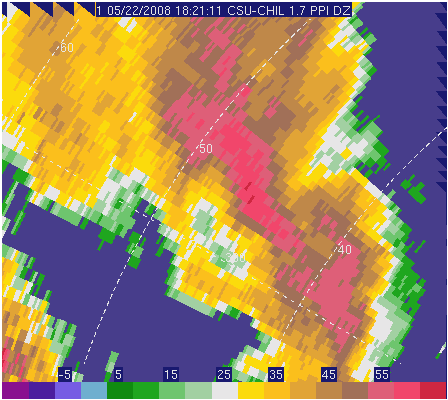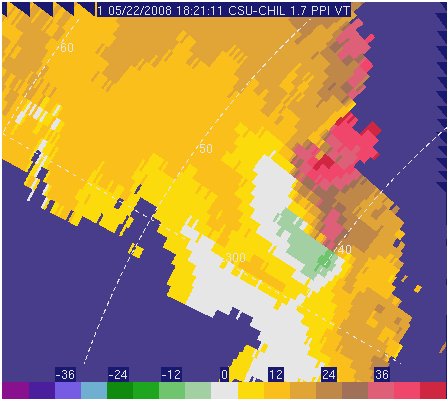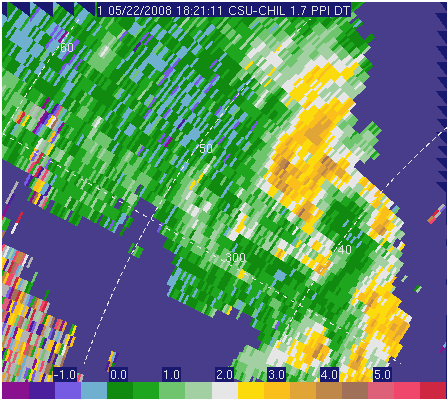Tornado Observation from May 22, 2008
<gmap lat="40.65" long="-105.05" zoom="12" width="650" height="650" showlabels="on" showscale="on">
points:
40.66473|-105.01583|Irrigation Pivot  Only isolated damage like this disrupted irrigation pivot, was found immediately west of I-25. (Click for a larger image.)
40.68169|-105.07159|An outbuilding was tipped over at this location. (Photograph not currently available.)
40.71173|-105.09533|House
Only isolated damage like this disrupted irrigation pivot, was found immediately west of I-25. (Click for a larger image.)
40.68169|-105.07159|An outbuilding was tipped over at this location. (Photograph not currently available.)
40.71173|-105.09533|House 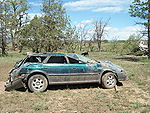 This parked car was swept around the corner of a house and rolled over.
40.71812|-105.09726|Barn
This parked car was swept around the corner of a house and rolled over.
40.71812|-105.09726|Barn 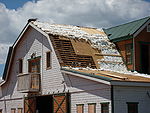 Portions of this well-constructed barn roof were removed.
kml:
http://www.chill.colostate.edu/kml/20080522/CHL_1823_dBZ_5.kml%7CdBZ
http://www.chill.colostate.edu/kml/20080522/CHL_1823_Vel_5.kml%7CVelocity
http://www.chill.colostate.edu/kml/20080522/CHL_1823_Wid_5.kml%7CSpectrum Width
http://www.chill.colostate.edu/kml/20080522/CHL_1823_RHO_5.kml%7CRho
http://www.chill.colostate.edu/kml/20080522/CHL_1823_ZDR_5.kml%7CZDR
</gmap>
Portions of this well-constructed barn roof were removed.
kml:
http://www.chill.colostate.edu/kml/20080522/CHL_1823_dBZ_5.kml%7CdBZ
http://www.chill.colostate.edu/kml/20080522/CHL_1823_Vel_5.kml%7CVelocity
http://www.chill.colostate.edu/kml/20080522/CHL_1823_Wid_5.kml%7CSpectrum Width
http://www.chill.colostate.edu/kml/20080522/CHL_1823_RHO_5.kml%7CRho
http://www.chill.colostate.edu/kml/20080522/CHL_1823_ZDR_5.kml%7CZDR
</gmap>
A tornadic supercell thunderstorm moved across parts of Weld and Larimer counties around mid-day local time on 22 May 2008. The town of Windsor, Colorado experienced extensive damage. On this date, the CSU-CHILL radar's antenna control system was still being adapted to the new dual offset feed antenna, so routine data collection operations were not possible. Once National Weather Service tornado warnings were issued, the radar was brought up. These efforts were hampered by commercial power fluctuations that were probably related to easterly surface winds that were gusting above 40 knots at the Greeley Airport.
CSU-CHILL data collection began shortly after the northwest-bound storm had crossed I-25 north of Ft. Collins. A survey of the region west of I-25 and north of Ft. Collins revealed spotty damage along the storm track. Damage observations are marked as landmarks on the basemap shown above. The most significant damage (a flipped car and RV; removed roof sections, etc.) was found at the two northwestern-most landmarks. The 1.7 degree elevation angle PPI scan data shown above was collected at 1830 UTC when the radial velocity rotation signature was nearest to the primary ground damage location.
Some interesting radar data values are found in the rotation area: On the inbound side, ZDR values are significantly more positive than the near 0 dB differential reflectivity levels typically found in hail. (For example, a near 0 dB ZDR / high reflectivity hail signature is present in the southern part of the echo system over northern Ft. Collins). The co-polar H,V correlation (rhoHV) values in the southwestern half of the circulation are slightly reduced from the typical "pure rain" levels (> ~0.98). Prior research (Ryzhkov et al, Bulletin of the American Meteorological Society, June, 2005) has associated significant rhoHV reductions (sometimes less than 0.5) in the immediate vicinity of tornadoes with echo returns from lofted debris. The rhoHV reductions seen here are not particularly large, but the tornado was dissipating at 1830 UTC. One region of high radial velocity spectral widths was essentially co-located with the flipped car landmark. This high spectral width patch may have been related to sub-pulse volume scale tornadic circulations. (Note: The radar was operating in simultaneous VHS mode during the time period shown here. The moment fields were calculated in post-processing from archived time series data; no clutter filtering was applied.)
These results are preliminary; additional, more extensive data analysis are anticipated in the future.
Time-lapse
Reflectivity
|
|
||
|
Velocity
|
|
||
|
Differential Reflectivity
|
|
||
|
